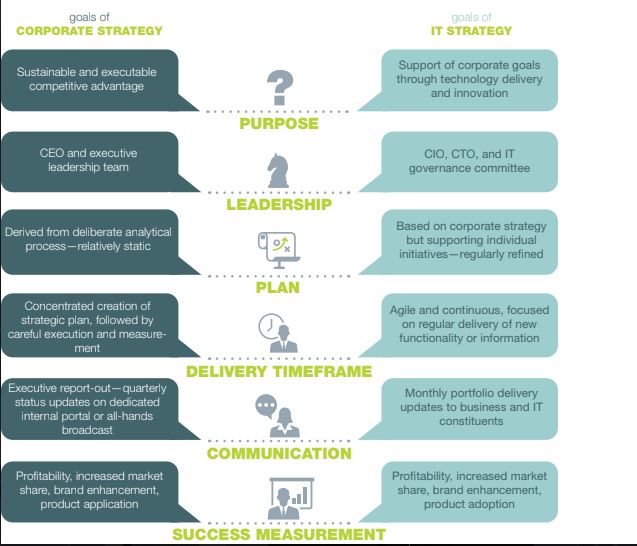
Why Your Corporate Strategy and IT Strategy Must Be In Sync
IT organizations that deliberately enable corporate strategy have five important advantages over those that focus solely on technology delivery.
- By Jill Dyché
- October 29, 2019
I recently addressed a group of CIOs and other IT executives at a vendor roundtable in New York City. The group was friendly and engaged, evidenced by how often they snapped pictures of my slides with their smartphones.
The flashes seemed to be particularly bright as I was discussing how IT should support strategy. In addition to photography from the audience, there were so many questions on the differences between company strategy and IT strategy that we had to continue the discussion over lunch.
In the dining room of a skyscraper overlooking the Hudson River, the CIO of a Latin American retailer summed up the collective conversation:
When you say the word "strategy," I think of my operations spreadsheet. I think of our cap ex budget and our headcount, but you are not talking about those things. Do I really have an IT strategy, and (as you recommend) how do I make sure my team's strategy matches our company's?
The image that lit up the camera phones was the one below. It was originally published in my book, The New IT, and it clearly has staying power, particularly with IT leaders struggling to transcend what my foreword author, Geoffrey Moore, in his game-changing book, Escape Velocity, calls the "gravitational field of your prior year's operating plan."

Republished with permission of McGraw-Hill Education, from The New IT: How Technology Leaders Are Enabling Business in the Digital Age by Jill Dyché, 2015; permission conveyed through Copyright Clearance Center, Inc.
On the left are the goals of corporate strategy, the collective actions that help a company succeed in its market. On the right are the goals of IT strategy, which supports corporate objectives by provisioning enabling technologies and innovation. Although both support a common overarching mission, corporate and IT strategies will result in different delivery tactics and outputs. They don't mirror one another as much as they complement one another.
IT leaders who understand corporate strategy are poised to help the company achieve its objectives. In my work with IT leaders, I've found that IT organizations that deliberately and visibly enable corporate strategy have important advantages over those that focus solely on technology delivery. These include:
- Better reputations. IT departments that provision technology to help further corporate goals are seen as partners -- not necessary evils -- by their business colleagues.
- Higher budgets. Strategically focused IT departments in general claim a higher percentage of corporate revenues than those that are more operationally focused.
- A seat at the table. IT leaders who understand and promote strategic alignment are included more often in high-level strategic planning, allowing them to help determine the company's direction and technology's role in it.
- Happier employees. Programmers, architects, data professionals, and other IT staffers are more fulfilled at work, feeling as if they are not only part of but critical to their companies' overall missions.
- Longer CIO tenure. In general, CIOs spend less time in their roles than other C-level executives. A 2018 report by the Wall Street Journal found that over half the CIOs surveyed only planned on staying in their jobs for another three years. CIOs who feel that they play a part in corporate governance tend to outlast CIOs who don't.
The word strategy is often layered with assumptions. Most companies still fall short of regular and deliberate strategic planning. CEOs and boards of directors can be suspicious of strategy or secretly don't understand its true purpose. Many dismiss it altogether. This is a failure of leadership but that doesn't mean IT should go down with the ship.
What should an IT executive do if his or her company isn't deliberate about strategic planning? Look for where the company is investing externally and support those investments. Creating the store of the future? Create a business case for emerging digital technologies. Buying up competitors? Prioritize systems and data integration efforts. Entering new markets? Modernize and extend your distribution networks. You get the idea.
Let your peers fight for budget and headcount while you slowly learn how to align with where your company needs to be. If you're lucky, you'll leave your position early not because you're disaffected but because another leadership team will find you and want you to do the same for them.
About the Author
Jill Dyché has advised clients and executive teams on their analytics and data programs for as long as she can remember. Longer, in fact. She’s the author of four books on the business value of technology and regularly talks to teams about what keeps them up at night. Ambivalent about analytics? Maddened by management? Constricted by your culture? Check out Jill’s Q&A column, Q&A with Jill Dyché, here.